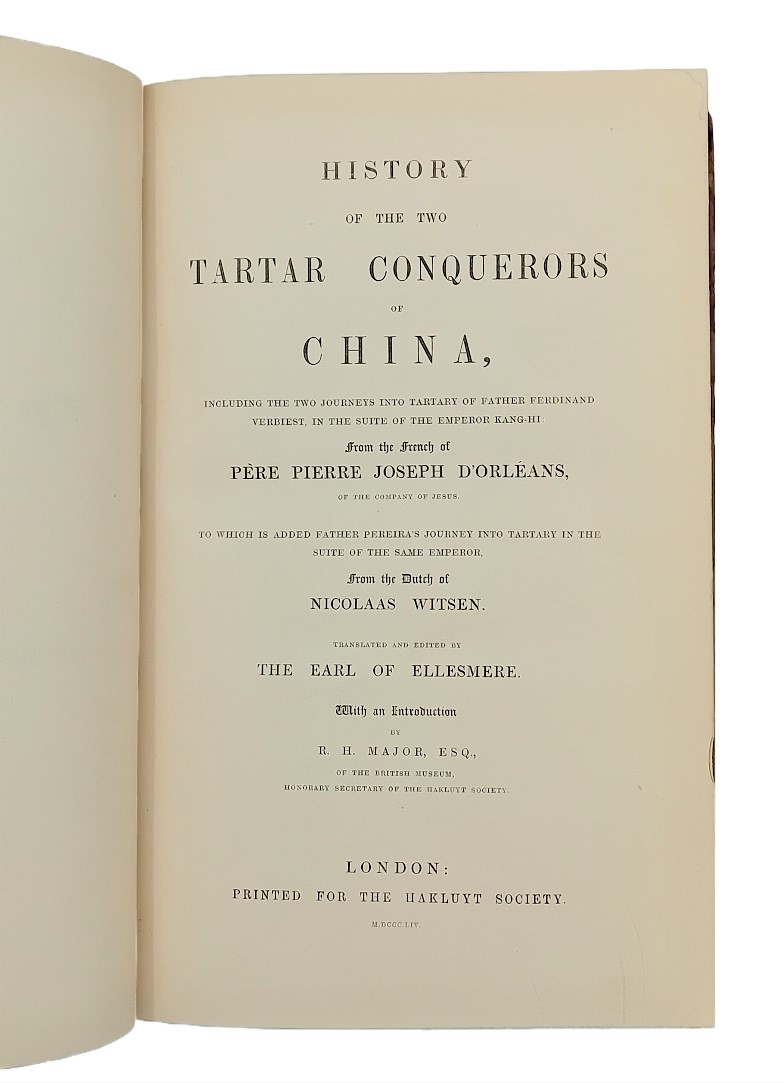
From Ming to Qing, revisited
ORLEANS, Pierre Joseph d’ and Francis EGERTON, 1st Earl of ELLESMERE (editor and translator).
History of the two Tartar conquerors of China, including the two journeys into Tartary of Father Ferdinand Verbiest, in the suite of the emperor Kang-hi … to which is added Father Pereira’s journey into Tartary in the suite of the same emperor ...
London, The Hakluyt Society, 1854.
8vo, pp. [6], xv, [3], vi, 153, [3]; light toning but otherwise a very good copy in original polished calf, spine gilt in compartments with two black morocco lettering-pieces (one chipped), marbled edges and endpapers; joints split, some wear to extremities, hinges repaired; bookplate of Ernst L.S. Benzon to front pastedown and his gilt emblem to upper cover, ‘bound by F. Bedford for Henry Stevens, 1859’ to front endpaper.

Added to your basket:
History of the two Tartar conquerors of China, including the two journeys into Tartary of Father Ferdinand Verbiest, in the suite of the emperor Kang-hi … to which is added Father Pereira’s journey into Tartary in the suite of the same emperor ...
First edition thus, a Hakluyt society translation of Pierre Joseph d’Orleans’ history of the Manchu conquest and the reign of the Kangxi emperor, appended with reports by the seventeenth-century Jesuit missionary travellers Ferdinand Verbiest and Tomás Pereira.
A Jesuit priest and prolific biographer, d’Orleans first published his history in 1688 based largely on the reports of Jesuit missionaries in China, including Martino Martini, François de Rougemont, Johann Adam Schall von Bell, and above all Ferdinand Verbiest, a close friend of the Kangxi emperor. His work ‘traces the events of the Shunchih reign, the Oboi regency, the Manchu conquest of the south, the campaigns against Koxinga (Cheng Ch’eng-kung), and the fate of several Ming pretenders and their heirs’. While detailed and in parts dramatic, it is not ambivalent: Orleans ‘made no effort to hide his preference for the Manchus in the post-1644 portions of the story, repeatedly contrasting Chinese effeminacy and exclusiveness with Manchu vigor and openness’ (Lach). Appended to the work were two letters by Verbiest describing his travels into Tartary – a catch-all term for the lands to the north of China, including present-day Kazakhstan, Mongolia, Russia and China – alongside his imperial friend.
This translation is by the British writer and traveller Francis Egerton, 1st Earl of Ellesmere, with an introduction by the geographer, curator and secretary of the Hakluyt society Richard Henry Major. As well as d’Orleans’ text, Ellesmere provides three additional appendices: two translations of Verbiest’s letters from the significantly different Dutch version first published in the Noord en Oost Tartarye (1692) of the Dutch burgomaster, trade official and amateur antiquarian Nicolaes Witsen, and an additional letter – also from Witsen – by the Portuguese Jesuit and accomplished mathematician Tomás Pereira, who accompanied the Kangxi emperor on a hunting expedition with the intention of teaching him the art of constructing musical instruments. According to Major, the reasons behind the reprinting of Orleans’ work were two-fold: firstly, and quite simply, on account of the ‘highly interesting narratives’ of the two Jesuit missionaries; and secondly, and more seriously, because ‘at a time like the present, when a revolution of the most formidable character has rendered the maintenance of the throne of China by the existing Tartar dynasty a matter of great uncertainty, the translation of a scarce work, by an author of celebrity, describing the establishment of that dynasty, seemed to have an especial claim upon the reader’s interest and attention’ (p. i).
Cordier, Sinica 629; Lach and Van Kley III, pp. 1675, 1679.
